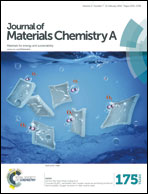‘Donor-free’ oligo(3-hexylthiophene) dyes for efficient dye-sensitized solar cells†
Abstract
The common trend in designing dyes for use in DSSCs with iodide-based electrolyte is based on a donor–π spacer–acceptor (D–π–A) architecture. Here, we report two ‘donor-free’ cyanoacrylic end-functionalized oligo(3-hexylthiophene) dyes (5T and 6T). Despite having no donor group, both dyes show reversible first oxidation process. Both 5T and 6T have n-hexyl alkyl chains to retard aggregation at different positions as well as different numbers of thiophene moieties. However, the dyes showed similar absorption properties and redox potentials. The DSSCs based on these dyes give power conversion efficiencies of more than 7%, although a significant difference in the VOC and FF has been observed. Using electrochemical impedance spectroscopy, this is attributed to the presence of more trap states when 6T attaches to TiO2 and modifies the surface, mainly affecting the fill factor. Overall, these dyes introduce a new and effective design concept for liquid-electrolyte DSSC sensitisers.


 Please wait while we load your content...
Please wait while we load your content...